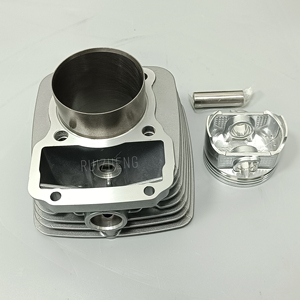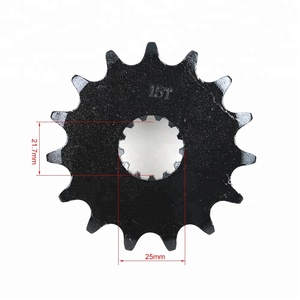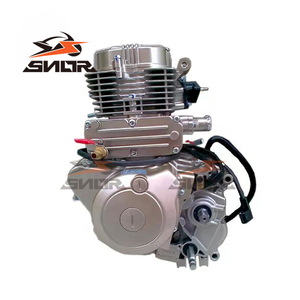Types of 350cc Engines
The 350cc engine category offers various configurations, each with unique characteristics suited for different applications. Understanding these differences is crucial for selecting the right engine for your needs.
Single-Cylinder 350cc
Design: One cylindrical combustion chamber
Best for: Motorcycles, smaller ATVs
Advantages: Simple design, easy maintenance, cost-effective, high torque at low RPM
Disadvantages: Significant vibration, uneven power delivery
Twin-Cylinder 350cc
Design: Two cylinders (V-shape or parallel)
Best for: Larger motorcycles, utility ATVs
Advantages: Smoother operation than single-cylinder, good balance between power and smoothness
Disadvantages: Higher maintenance requirements, increased manufacturing costs
Triple-Cylinder 350cc
Design: Three cylinders
Best for: Sports motorcycles, high-performance applications
Advantages: Excellent smoothness, high power output across wide RPM range
Disadvantages: Complex design, expensive to manufacture and maintain
Four-Cylinder 350cc
Design: Four cylinders
Best for: High-performance motorcycles
Advantages: Maximum smoothness, highest power output, higher achievable RPMs
Disadvantages: Most complex and expensive option, higher maintenance requirements
Power Output Comparison
Expert Tip: When selecting between different cylinder configurations, consider not only the power needs but also the intended use. Single and twin-cylinder engines excel in applications requiring low-end torque, while triple and four-cylinder engines provide better high-speed performance.
Specifications of 350cc Engines
Understanding the key specifications of 350cc engines helps in making informed decisions about selection, operation, and maintenance.
| Specification | Details | Importance |
|---|---|---|
| Displacement | 350 cubic centimeters (0.35L or 21.4 cubic inches) | Defines the engine category and basic power potential |
| Configuration | Various (single, twin, triple, or four-cylinder) | Affects smoothness, power delivery, and application suitability |
| Power Output | ~20-35 horsepower (varies by configuration) | Determines acceleration and top speed capabilities |
| Torque | ~25-350 Nm (depending on design) | Affects low-end power and ability to handle loads |
| Fuel Type | Gasoline (possibly with ethanol blends up to 15%) | Required for proper operation and longevity |
| Ignition System | One spark plug per cylinder, electronic ignition | Critical for reliable starting and efficient combustion |
| Cooling System | Water or air cooling with thermostat regulation | Prevents overheating and ensures consistent performance |
| Oil Type | High-quality motor oil specific to application | Essential for proper lubrication and engine longevity |
Maintenance of 350cc Engines
Proper maintenance is crucial for ensuring the longevity, reliability, and performance of any 350cc engine. Following a regular maintenance schedule will help prevent costly repairs and downtime.
-
Regular Oil Changes
Frequency: Every 3,000 miles or 3 months (whichever comes first)
Importance: Fresh, clean oil ensures proper lubrication of engine components, reducing wear and extending engine life.
Tip: Always use the manufacturer-recommended oil grade and viscosity for optimal performance.
-
Air Filter Replacement
Frequency: Every 15,000 miles or annually
Importance: A clean air filter ensures proper air-fuel mixture, improving performance and fuel efficiency.
Tip: Inspect more frequently if operating in dusty environments.
-
Spark Plug Replacement
Frequency: Every 30,000 miles or 3 years
Importance: Fresh spark plugs ensure efficient combustion, smooth operation, and optimal fuel economy.
Tip: Check plug gap before installation to ensure proper ignition.
-
Fuel System Cleaning
Frequency: Every 10,000 miles or annually
Importance: Removes deposits from fuel components, improving fuel flow and engine performance.
Tip: Consider using quality fuel with detergent additives between cleanings.
-
Cooling System Flush
Frequency: Every 30,000 miles or 2 years
Importance: Maintains proper temperature control and prevents corrosion.
Tip: Always use manufacturer-recommended coolant type and mixture ratio.
-
Timing Belt Replacement
Frequency: Every 60,000 miles or 5 years
Importance: Prevents catastrophic engine damage from belt failure.
Tip: Consider replacing tensioners and pulleys simultaneously.
-
Regular Inspection Checks
Frequency: Every 5,000 miles or 6 months
Importance: Identifies potential problems before they lead to major failures.
Tip: Create a checklist including all fluid levels, belts, hoses, and electrical connections.
Warning: Neglecting regular maintenance can lead to decreased performance, reduced fuel efficiency, and potentially catastrophic engine failure. Always follow the manufacturer's recommended maintenance schedule.
How to Choose a 350cc Engine
Selecting the right 350cc engine requires careful consideration of several factors to ensure it meets your specific needs and applications.
Purpose & Application
Consider the intended use:
- Motorcycles: Focus on power-to-weight ratio and smoothness
- ATVs: Prioritize torque and durability
- Generators: Look for reliability and fuel efficiency
- Snowmobiles: Consider cold-weather performance
Key question: What will this engine be powering?
Brand & Reputation
Research manufacturer reliability:
- Check customer reviews and satisfaction ratings
- Research warranty terms and support options
- Consider parts availability and service network
- Look for manufacturer specialization in your application
Key question: Which brands are known for quality in this specific application?
Performance Requirements
Assess your performance needs:
- Power output requirements for your application
- Torque needs (especially for towing/hauling)
- Speed vs. low-end power priorities
- Fuel efficiency requirements
Key question: What performance characteristics are most important for your use case?
Budget Considerations
Financial planning:
- Initial purchase cost
- Long-term maintenance expenses
- Fuel efficiency and operating costs
- Potential for future upgrades
Key question: What is your total budget including purchase and maintenance?
Expert Advice: Don't simply choose the most powerful engine within your budget. Match the engine characteristics to your specific application for optimal results. For recreational vehicles, consider your skill level and intended use. For utility applications, prioritize reliability and torque over maximum power output.
How to DIY Replace a 350cc Engine
Replacing a 350cc engine yourself can save money and provide valuable mechanical experience. Follow this step-by-step guide for a successful engine swap.
1. Preparation
Read manual thoroughly
Gather all necessary tools
Set up well-lit workspace
Wear appropriate safety gear
2. Disconnection
Disconnect power source
Remove all electrical connections
Detach fuel lines and hoses
Label all connections
3. Removal
Remove mounting bolts
Detach from frame/chassis
Carefully extract old engine
Inspect mounts for damage
4. Installation
Position new engine
Secure mounting points
Verify alignment
Tighten to spec torque
5. Connection
Reconnect all wiring
Reattach fuel/cooling lines
Install all accessories
Double-check connections
6. Testing
Verify fluid levels
Check for leaks
Start engine briefly
Perform full function test
Safety Warning: Always disconnect the battery or power source before beginning work. Ensure the engine is completely cool before starting work. Use proper lifting techniques and equipment when removing and installing engines to prevent injury.
Pro Tip: Take multiple photos during the removal process from different angles. These visual references will be invaluable during reassembly. Consider creating a diagram of all connection points or using small bags labeled with the connection type and location to organize fasteners and connectors.
Frequently Asked Questions
A: A 350cc engine refers to an internal combustion engine with a displacement volume of 350 cubic centimeters (0.35 liters). This measurement indicates the total volume of all cylinders in the engine. These engines are commonly used in motorcycles, ATVs, snowmobiles, and small utility vehicles due to their good balance of power, efficiency, and compact size.
A: The power output of a 350cc engine typically ranges from 20 to 35 horsepower, depending on the design, number of cylinders, compression ratio, and tuning. Single-cylinder designs usually produce around 20-25hp, while multi-cylinder configurations can reach 30-35hp or more. Modern fuel injection and advanced materials can increase these figures further.
A: 350cc engines offer numerous benefits including:
- Excellent fuel efficiency compared to larger engines
- Lower operating and maintenance costs
- Adequate power for most small vehicle applications
- Compact size and lighter weight
- Generally quieter operation
- Good balance between performance and economy
- Versatility across different applications
A: Yes, a 350cc engine can be suitable for off-road riding, particularly in the right configuration. These engines provide enough power for most off-road conditions while remaining manageable for riders with intermediate experience. For optimal off-road performance, look for 350cc engines with:
- Higher torque output at lower RPMs for better traction
- Robust air filtration systems for dusty conditions
- Cooling systems designed for lower-speed operation
- Reinforced components to handle rough terrain
While larger engines might offer more power for extreme conditions, a well-designed 350cc engine strikes an excellent balance between performance, maneuverability, and control for most off-road applications.
A: The top speed of a 350cc motorcycle typically ranges from 70-100 mph (110-160 km/h), depending on several factors including the engine configuration (single vs. multi-cylinder), aerodynamics, gearing, rider weight, and whether the bike is designed for sport or cruising. Sport-oriented models with multi-cylinder engines tend to reach higher top speeds than utility-focused single-cylinder designs.
A: For optimal performance and longevity, a 350cc engine should follow this general service schedule:
- Oil changes: Every 3,000 miles or 3 months
- Air filter inspection/replacement: Every 5,000-15,000 miles depending on conditions
- Spark plug replacement: Every 10,000-30,000 miles or 1-3 years
- Valve clearance checks: Every 15,000-20,000 miles
- Major service (including timing components): Every 15,000-30,000 miles
Always refer to your specific engine's owner manual, as maintenance requirements can vary significantly between manufacturers and engine designs.


























































































































































































































































 浙公网安备 33010002000092号
浙公网安备 33010002000092号 浙B2-20120091-4
浙B2-20120091-4